All our fantasy baseball rankings for 2023 can be found inside our Draft Kit. Sign up to PL Pro to access all our 2023 player projections with our auction draft calculator.
Before we get started, I’ll briefly review my basic assumptions and philosophy:
These rankings assume a 5×5 head-to-head categories format with one catcher, one first baseman, one second baseman, one shortstop, one third baseman, three outfielders, two utility hitters, a shallow bench, and at least two IL spots. I am also assigning eligibility based on five starts at the position, so don’t be entirely shocked if your host site doesn’t list some of these guys at each position I list below. The scoring categories for hitters that I’m basing these rankings on are runs scored, home runs, runs batted in, stolen bases, and batting average.
Unlike deeper formats with an overall component like the NFBC, standard head-to-head leagues don’t put much of a premium on stolen bases. Additionally, the relatively high replacement level at most positions suppresses the value of players with high floors but low ceilings (like Jean Segura), so as we get to the later part of the rankings you’ll see that I value upside quite a bit more than safety.
There are leagues of all shapes and sizes out there, and I can’t possibly accommodate all of them in a single set of rankings. Don’t hesitate to reach out in the comments if you want to know whether a setting or situation would dramatically change a ranking, but in general, players won’t slide up or down more than one or two tiers (most will move even less) unless it’s an extreme or highly unusual scenario.
With that out of the way, let’s dive into the rankings!
Tier 1
1. Trea Turner (PHI), SS
Say hello to one of just two players to finish in the top-five overall hitters in three of the last five seasons (José Ramírez has done it four times in that span). Turner brings five category contribution year in and year out and will once again sit at the top of a playoff contender’s lineup in his new home in Philadelphia, and isn’t even turning 30 until about midway through the season (not that there’s anything inherently wrong with turning 30).
I suppose Turner could lose some stolen bases if he were to drop to second or third in the order, according to the research done in this recent article by the great Jeff Zimmerman over at FanGraphs. That said, the Phillies’ current roster doesn’t have many other obvious leadoff candidates (unless you count Schwarber, who would only likely bat first in Turner’s absence) and plenty of guys who can hit second through fourth in Schwarber, Hoskins, Realmuto, Castellanos, and Bohm.
The only real question you’re asking yourself about Trea Turner is where to rank him in your top-five overall players. Personally, I have Turner at two—third base has a major depth issue and by the time the pick would come back to you, assuming you’re picking early in the draft, four or five of the top five third basemen will likely be gone, leaving you trying to play catch-up despite only having made one pick.
Shortstop, on the other hand, remains one of the deepest positions in fantasy, and certainly the deepest position in the infield, so passing on Trea Turner for pick one doesn’t preclude you from drafting an elite shortstop (like the ones in the next tier). You can even choose to wait at shortstop and still find a very good one, as the third tier for this position has a whopping 10 names, and I’d be more than comfortable with any one of them as my starting shortstop, especially considering the relatively high replacement level in 12-team formats.
2. Bo Bichette (TOR), SS
If you just looked at Bichette’s final season totals, you’d think he had yet another consistent fantasy performance; however, you’d be mistaken. Bichette was actually looking a bit like a bust as he slashed just .257/.302/.418 in the first half and his 14 home runs through July 31st had him outside the top 50 in total home runs.
Of course, those two rostered or faced off against Bichette in the second half know how the rest of this story goes (but I’ll use some charts to show you anyway):
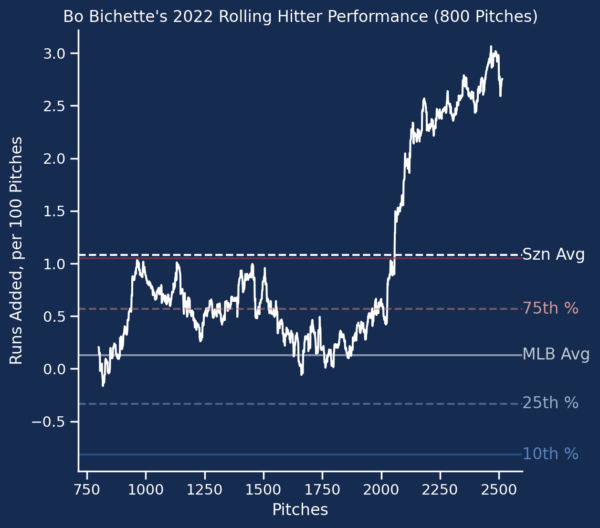
Bichette made an enormous leap towards the end of the season, and while I can’t really give you a single specific root cause for the jump, I can show you some adjustments Bichette made as the season wore on to help him bust his slump.
First, Bichette made some adjustments in two-strike counts by cooling off a little in terms of aggression, which helped him make better contact (which makes sense, as only swinging at pitches you might be able to hit will usually lead to hitting more pitches):
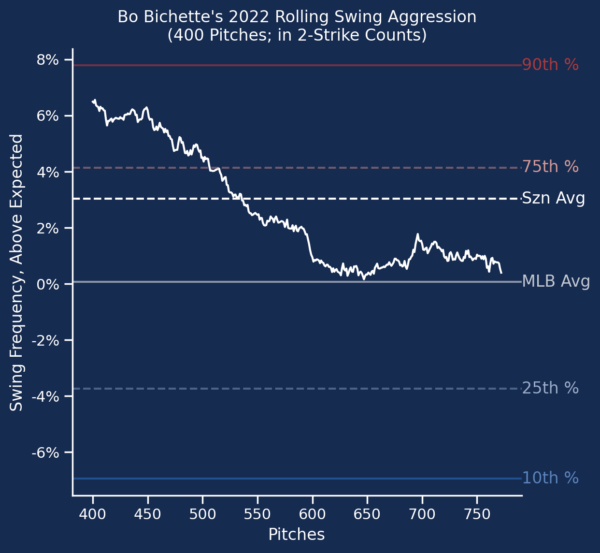
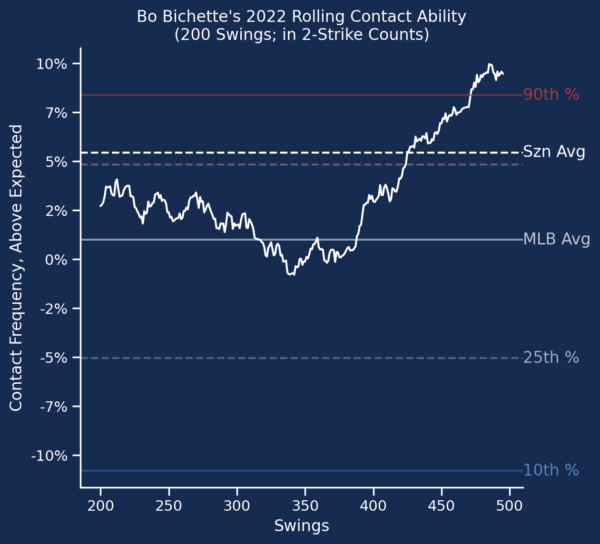
Further, and perhaps more importantly for fantasy, Bichette became much more strict with the strike zone when he was ahead in counts. After all, the best time to be patient is when the batter is ahead because if you don’t like this pitch, you know for sure you’ll get another one. As a result, he was able to really hone in on the pitches he knew he could connect with (even if they were pitches other players might struggle with) because Bichette still has an elite hit tool.
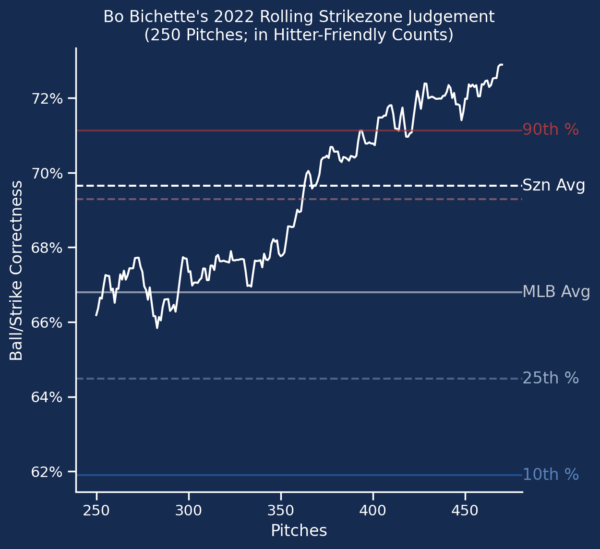

Armed with a little bit better judgment of the zone and his excellent tools, Bichette is primed for a run at 25 or more home runs, 15 or more stolen bases (he had 25 back in 2021 and the rule changes should help), a boatload of counting stats, and a .290 or better batting average.
3. Fernando Tatis Jr. (SDP), SS
Tatis Jr. missed all of 2022 due to shoulder and wrist issues combined with a suspension later in the season that will extend through about the first month of 2023, but none of that is enough to forget the kind of per-game production Tatis has put together in his first three seasons in the big leagues. In just 130 games in 2021, Tatis smacked 42 home runs and stole 25 bases while slashing .282/.364/.611. Of course, issues with Tatis have never been about what he can do on the field—they’re about whether he can stay on it.
Shoulder surgeries are rough as shoulders are more complex than elbows. Jeff Zimmerman put together a nice article on this topic for FanGraphs, and while I do think Tatis is a bit of a unicorn considering how well he played with that injured shoulder in 2021, it’s impossible to ignore the injury risk.
Most fantasy managers likely already have an opinion on their risk tolerance and willingness to draft Tatis Jr. at the middle or end of the first round. As you can see from my rankings, I’m all for it in 12-team leagues, especially those with IL spots, due to the overall depth at shortstop (allowing you to buy time until his return) and the unbelievable upside.
Even if Tatis drops his barrel rate by seven points from his 2021 numbers (which is close to the league average barrel rate per batted ball event), he’d still likely finish in the top 25 in the league in barrels. Even if Tatis lost 100 points in slugging from 2021, he’d slug just north of .500. Sure, Tatis is likely to drop some production and upside from the injuries, suspension, and recovery, but this is a player who had potentially more upside than any other player in the league.
I ranked Fernando Tatis Jr. first overall last season (which obviously didn’t pan out quite the way I hoped), and while I’m discounting him due to the risk, I can’t imagine letting him get to the second round.
4. Bobby Witt Jr. (KCR), 3B/SS
Bobby Witt Jr.’s rookie campaign went as well as you could possibly hope as he notched 20 home runs and 30 steals with a solid .254 batting average. While those three things don’t come as a surprise, I have to admit that I was pleasantly surprised to see that Witt scored 82 runs and drove in 80 runners—quite a feat when you play in the woeful Royals offense.
There’s still some development I expect to see from Witt. First and foremost, he needs to be able to get on base at a better rate. There are a few ways he can accomplish this, with perhaps the most simple being laying off more pitches that are out of the zone (his 37.3% o-swing rate was the 20th-highest mark among 130 qualified hitters).
It’s not that Witt misses too often or strikes out too much, it’s that he makes weak contact on those pitches. While we want Witt to be aggressive due to his bat-to-ball skills and plus power, we don’t want that power wasted on pitches he can’t do anything with.
The other path to getting on base would be being more passive overall—Witt hovered around the 75th percentile most of the year in terms of swing aggression—which would draw more walks. Witt did manage to walk at about a 9% clip over 123 games in Double-A and Triple-A back in 2021, and even a modest bump to his 4.7% walk rate in 2022 would help him get that .294 OBP over the .300 hump and closer to something like .310 or .315, which could help him steal a handful more bases and keep that run total north of 80.
Tier 2
5. Francisco Lindor (NYM), SS
The switch-hitting shortstop may not be the superstar he was prior to the pandemic (three straight seasons of 32 or more home runs, 99 or more runs scored, 15-25 stolen bases, and a .273 or better batting average), but 2022 showed us that Lindor still has enough left in the tank to pile up counting stats with above-average pop and speed as part of a rebuilt Mets lineup.
I can’t really point to a single change Lindor made, nor can I tell you about a trend I’m seeing in the underlying data, though Lindor has always been a player who outperformed his peripherals, even when he was a superstar.
He’s never had a 10% barrel rate in a season nor has he ever had a 45% hard-hit rate, and yet Lindor finished as fantasy’s second-best shortstop last season due to his five-category production, and he should be considered extremely safe as a top-five to top-eight shortstop coming into 2023. Floor isn’t always very exciting, but it’s critical to winning fantasy championships.
6. Corey Seager (TEX), SS
You’ve probably heard about how Seager was brutalized by the shift, batting just .245 in 2022 in large part due to losing tons of likely base hits by putting the ball right into a shifted infielder’s glove. It’s true, few players were shifted as often as Seager and it was quite effective in limiting hits, taking 80 points off his batting average on groundballs and roughly 100 points from his batting average on grounders and line drives. Seager is a perfect example of a hitter who is likely to benefit from the new rules that prevent overloading one side of the infield, and while teams will still likely use defensive positioning to take hits away, the new rules combined with just some good ol’ fashioned regression to the mean should help Seager be something more like his career .287 batting average.
That said, I wouldn’t necessarily expect Seager to go back to being a .300 hitter, as part of the reason the shift was so successful is that Seager has intentionally started pulling the ball over the last three seasons. While he doesn’t pull a lot of fly balls (a trait that can help significantly increase home runs), Seager did pull the most fly balls of his career in 2022 thanks to a combination of a career-high pull rate and close to a career-high fly ball rate. That combination accounted for 15 home runs and three doubles in 2022 on 37 pulled fly balls and considering Seager has a 2.512 OPS on pulled fly balls in his career, I’d say I’m more than happy to see a modest reduction in batting average (to something like, say, .270 or .275) if it means he keeps yeeting pitches over the wall in right field.
If Seager can come close to 30 home runs again while regaining 30 or 40 points of his lost batting average (a high number, but also a reasonable one considering his skill set), Seager could wind up in the top tier of shortstops in 2024—a remarkable feat for a guy who has never stolen five bases in a season.
7. Marcus Semien (TEX), 2B/SS
You can be disappointed that Semien dropped over 100 points of slugging between 2021 and 2022, but you can’t complain too much about the overall results—26 home runs, 25 stolen bases, and 184 combined runs and RBI made Semien the third-best second baseman in fantasy in 2022 (second-best if you don’t count Mookie Betts). This would come as a surprise to anyone who stopped paying attention to baseball at the end of April, as he was baseball’s third-worst second baseman by wRC+ at that moment with a paltry and pathetic 26 (meaning he was 74% worse than the average second baseman up to that point).
Many of us analysts wondered if Semien was pressing at the plate and being overly aggressive, as many players admit to when they first appear for a new team with a big new contract, and the rolling charts below certainly suggest that may have been the case:

What you’re seeing above is that Semien generally swings less often than other players at most pitches, except for that brief period at the start of 2022 where he swung much more often than most players would. He wasn’t swinging and missing, mind you—he was just trying to hit everything he could reach, and that’s not really a path to success for Semien. He seemed to settle in as the season went on, and that’s exactly what we see in the numbers.
In short, Semien should be at least as good as he was last season now that the aggression is back under control, and now that he isn’t starting way behind, he could even be better than he was in 2022. I’m hesitant to say Semien can match his insane 2021, but 30 home runs and an improved batting average are both fairly reasonable expectations.
Tier 3
8. Willy Adames (MIL), SS
Coming into 2022, we hoped for 30 home runs as part of the Brew Crew, and to Adames’s credit, that’s what we got. Adames posted career highs in home runs, runs scored, RBI, and stolen bases in 2022, though he did also put up a career-worst .238 batting average.
I don’t think Adames is a .238 hitter going forward, but the underlying Statcast numbers never really believed in him as a .260 hitter, either, so perhaps splitting the difference and projecting a .250 batting average is a pretty reasonable expectation, especially given the double-digit barrel rate over the last two seasons. Even with modest speed and a modest batting average, Adames’s place at the heart of Milwaukee’s lineup and his 30-home run power give him a rather safe floor, especially when compared to his colleagues in this tier, and he makes for a nice target if you chose to focus on other positions for the first seven rounds or so of your draft (especially if you feel a little light on power).
9. Oneil Cruz (PIT), SS
Oh gosh, where to even begin. It’s easy to point at Cruz’s 34.9% strikeout rate and average walk rate and see signs for concern—and you’re totally rational for feeling that way. I’m not very rational about Cruz, though, and the following charts might help explain why I’m so excited about what’s to come:
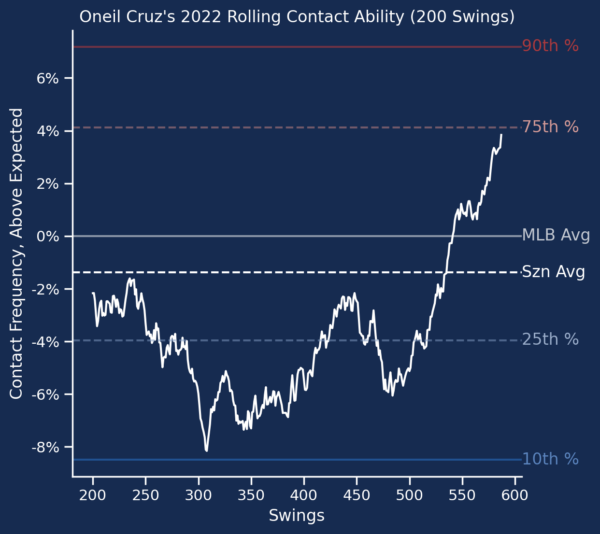
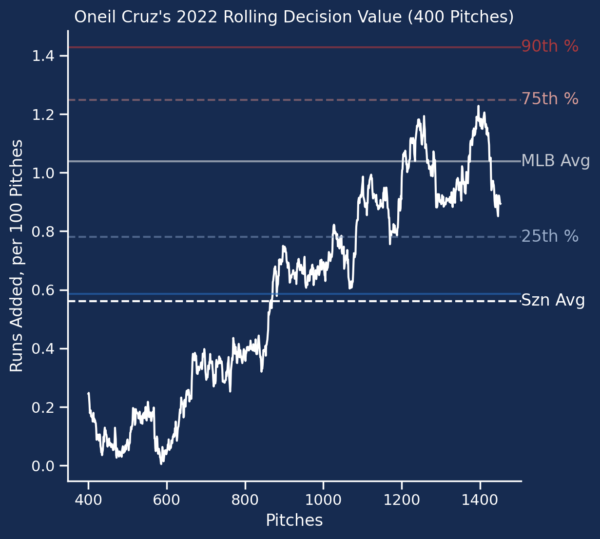
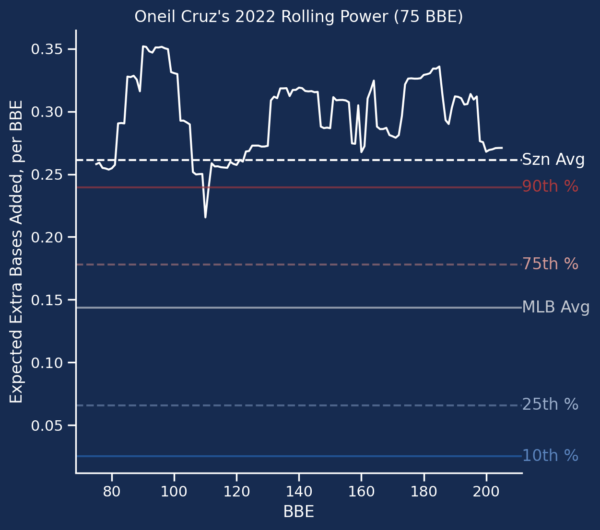
So not only can Cruz hit the ball harder than anyone else (100th percentile max exit velocity thanks to a 122.4 mile per hour missle that was only a single due to how hard it hit off the right field wall at PNC Park), run faster than almost everyone else (98th percentile sprint speed), and throw harder than almost everyone else (97th percentile arm strength), but Cruz is also getting better at making smart decisions in the box and making contact without sacrificing power (which is a little of what we saw with the much more disciplined Vinnie Pasquantino).
Simply put, the 6’7 shortstop has tools that are truly off the charts, and with clear signs of growth as he got more experience at the big league level, the sky is the limit for what Cruz could do. Sure, you have to bake in some risk due to his propensity for chasing pitches and his very short track record, but when it comes to shooting for upside based on raw ability, Cruz is as good as it gets.
10. Wander Franco (TBR), SS
The uber-prospect of uber-prospects heading into 2021, Franco has had to battle injuries through his first two big league seasons. In his 153 games played to date, Franco is slashing .282/.337/.439 with 13 home runs and 10 steals—certainly nothing to sneeze at, but not something to get overly excited about either. Of course, it’d be foolish to suggest that we know what to expect going forward for a player who at the time of this writing is still just 21 years old, but we have learned a few things about what to expect in the short-term for Wander Franco.
First, Wander is not a power-first prospect. His hit tool carries his profile as he is a master of making contact, even in the major leagues:
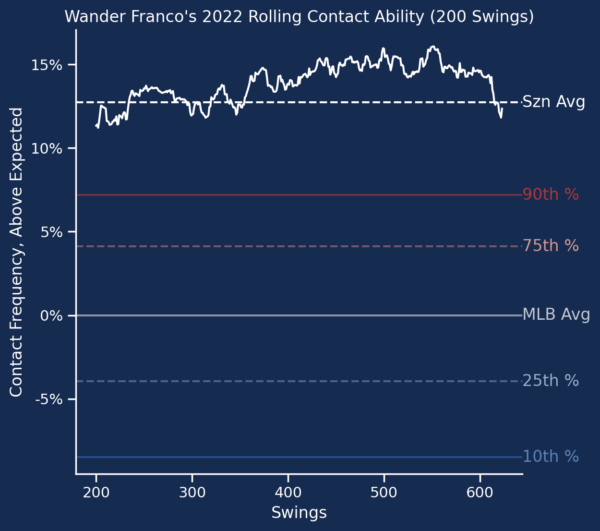
However, Franco’s elite hit tool also lends itself to over-aggression, which is good in some sense as he can make contact on pitches other hitters can only flail it, but it also can limit his ability to make hard contact. As 2022 wore on, we didn’t see a significant spike in production, but we did get a drop in his aggression relative to the types of pitches Franco was seeing:
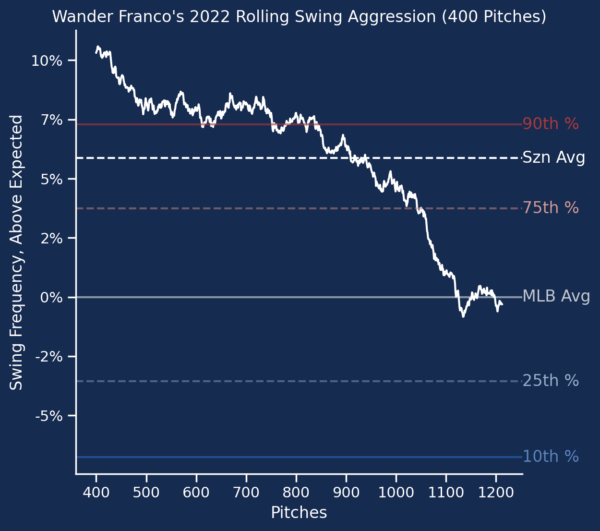
I’d love to see Franco maintain an average to slightly above-average swing aggression while maintaining his superfluous contact ability, as it could help him hone in on the types of pitches he can do the most damage to. A successful, healthy season for Franco with improved patience could look like a 20-home run, 12-15-stolen base player with a .290 batting average, 100 runs scored, and 90 RBI, which would put him at or near the top of this tier.
I don’t necessarily expect that from him quite yet, but don’t be overly discouraged by what appear to be ho-hum numbers from most projection systems. There are precious few players from the last decade with this kind of bat-to-ball ability, and I can’t think of any player who has showcased this kind of skill before they turned 22 years old, and that’s something worth chasing.
11. Andrés Giménez (CLE), 2B/SS
It was a breakout season for the 24-year-old middle infielder, as Giménez hit 17 home runs, stole 20 bases, and slashed .291/.371/.466 in his first full major league season with the Guardians. Giménez had an improved barrel rate while also hitting more balls up the middle instead of to the pull field and more line drives, all of which had good impacts on his batting average.
Advanced stats, including the expected stats we use here at Pitcher List, suggest that Giménez was a bit fortuitous in the batting average department, but even if he gives up 20-30 points, Giménez remains a highly valuable middle infielder at the top of a lineup that should hopefully be at least average. That said, he could improve his contact ability to make up for some of the loss of luck. I’m also not expecting a ton of growth in the power department, but 15 home runs seem like a safe bet to go with 20-25 steals.
12. Dansby Swanson (CHC), SS
It all came together for Swanson in 2022—he was able to bat second for most of the season, he broke through the bad luck he suffered from in 2021, and he stayed healthy as part of a good offense to generate a top-three performance at shortstop in 2022, ahead of guys like Bo Bichette, Bobby Witt Jr., and Marcus Semien. While Swanson doesn’t have an elite tool to hang his hat on, his ability to put up above-average numbers in all five categories helped propel him to the top tier of shortstops in terms of actual performance last season.
It’s not as though I think Swanson had some sort of unbelievable good fortune or faked his way to a strong performance—it’s just that everything broke Swanson’s way, and that’s just really difficult to bank on in back-to-back seasons, especially as he goes to a considerably less talented lineup on the north side of Chicago than what he had in Atlanta. Nico Hoerner, Ian Happ, and Seiya Suzuki aren’t bad players, but they’re a far cry from Ronald Acuña Jr., Michael Harris II, Austin Riley, and Matt Olson. That downgrade in supporting cast will make it extremely difficult for Swanson to pile up counting stats, and prior to 2022, Swanson had never cleared 80 runs scored or 90 RBI.
This doesn’t mean Swanson is bad—80 runs scored and 90 RBI are a lot of counting stats, and those numbers, while a tad high, are potentially attainable in Chicago. I just can’t see how he gets to the 99 runs scored and 96 RBI in 2023, and even with the rule changes, it’s hard to project more than 12-15 stolen bases despite the 18 he swiped in 2022 due to his previous career high being just 10.
In other words, Swanson could give us the exact same skills in 2023 as he did in 2022, but because he’s not right in the thick of one of the National League’s best offenses, it’s hard to see how he accumulates enough value across all five categories to finish inside the top five at shortstop again. The top ten is doable, sure, but I’m thinking the top-12 to top-15 is a more reasonable expectation when planning for drafts.
13. Tommy Edman (STL), 2B/SS
Make it two straight seasons with double-digit home runs, 30 steals, and a .260 batting average for Edman. The versatile and speedy infielder should continue to hit at the top of a Cardinals lineup, giving him a pretty good chance to score 90-100 runs. Sure, Edman flashed more plus power in his debut when he hit 11 home runs in just 92 games, but once you realize that power surge was in the infamous 2019 season, you realize that 10-15 home runs are probably all you can get from him.
Those in formats that put a premium on steals (like the NFBC) should probably put Edman above Giménez, but in head-to-head category formats, steals are a bit less important. Giménez provides a higher ceiling for power and ratios than Edman, so I gave Giménez the edge in standard formats.
14. Tim Anderson (CHW), SS
Anderson hasn’t played 125 games in a season since 2018, though when he does play, Anderson continues to show he can hit for a high average and steal plenty of bases. Prior to 2022, Anderson also had 20-25 home run power (assuming he could actually play 140 or more games, which stopped happening after 2017), but the power took a significant step back last season as he hit just six home runs in about half a season of action (79 games).
Nothing in his batted ball profile from last season shows a marked change from years past, and with injuries sending him to the IL in both June and August, it isn’t all that much of a stretch to suggest that injuries sapped his power as opposed to a skill degradation.
I still believe in Anderson as a 15-home run, 20-stolen base guy if he can get to 135 games played—though that’s a big if. The high replacement level at shortstop in 12-team formats helps soften that blow, but if I was making Anderson a part of my draft strategy, it’d be because I wanted to prioritize speed or because I already had a strong shortstop on the roster.
15. Xander Bogaerts (SDP), SS
Xander Bogaerts‘ 15 home runs in 2022 felt like such a low number to me considering the reputation I had for him in my head, but looking at the stat lines, Bogaerts only has one season with more than 23 home runs—and it was in the infamous 2019 campaign. 15 home runs for Bogaerts is still probably on the low end for what to expect, but in context, it’s not necessarily indicative of a new power standard.
Heading into 2023, Bogaerts finds himself batting fourth for a top-heavy Padres lineup behind Juan Soto and Manny Machado, which is all but certain to help him vastly improve upon his meager 73 RBI in 2022. In fact, should Bogaerts stay healthy all season (he has played in at least 136 games each full season since becoming a full-time player in 2014, and he played in 56 of the 60 games in 2020), I think he can threaten 100 RBI for the first time since 2019.
Bogaerts also has modest speed, stealing at least eight bases in six of the last eight seasons, so the rule changes that will boost stolen bases could help him reach double-digits for the first time since 2017 as well.
Even if Bogaerts fall short of 20 home runs for back-to-back seasons for the first time in his career, boosts to all of his other counting stats combined with his always strong batting average (he’s a career .292 hitter) gives Bogaerts a nice floor and ceiling combination that’s hard to pass up at this point in the draft, especially if you’re late to the shortstop party.
16. Carlos Correa (MIN), SS
With back-to-back healthy seasons for the first time in his career, Correa feels like a much safer option than he has in years past despite the contract drama that generated so much buzz in the offseason.
Speaking of that drama, I think it’s important to note that the injury issues that caused the Giants and Mets to back out are not issues that are expected to impact his 2023 outlook—those issues were much more long-term in nature and only caused such a fuss because of the length of those offered contracts. Expecting 150 games from Correa is a bit too aggressive, most likely, but 135-145 games is well within the realm of possibility.
With that kind of playing time, Correa should be able to swat 23-25 home runs with a .280 batting average and an OBP north of .350. Counting stats are a bit of a question mark as the Twins’ offensive firepower seems to hinge on Buxton’s ability to stay healthy (which is never a safe bet) and some rebounds from Jorge Polanco, Max Kepler, and gulp Joey Gallo, and/or breakouts from young sluggers like Alex Kirilloff or Nick Gordon.
I’m not sure how much of that can break right in 2023, so my outlook on runs and RBI for Correa are pretty low for a player of his talent, but his power and batting average should carry enough value for him to be a great middle infield option in 12-teamers, and in a pinch, he could be a useful starter if you somehow forgot to draft a shortstop in the early rounds.
17. Gunnar Henderson (BAL), 3B/SS
After just 34 games in the big leagues, several major projection systems are penciling in over 20 home runs with double-digit steals for the former top prospect—not too shabby at all right? On one hand, our PLV metrics had a lot of nice things to say about Gunnar, particularly related to his strike zone judgment and his improving decision-making skills:
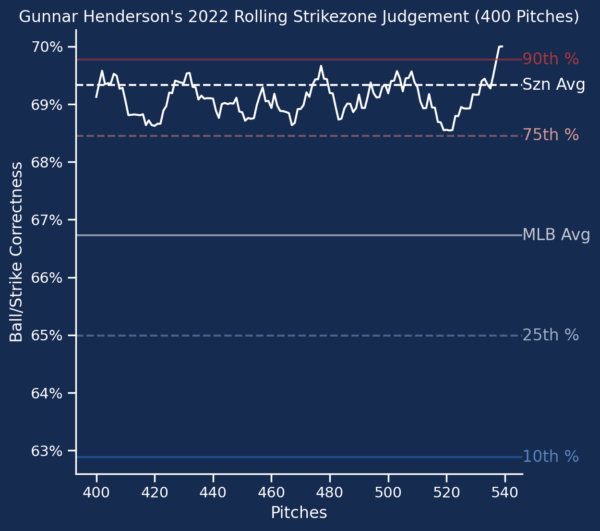
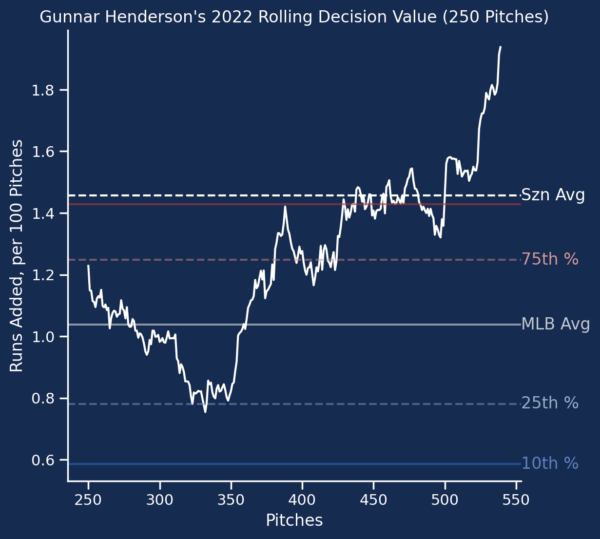
While these are excellent developments that suggest he can improve his batting average and ratios at the plate, Gunnar does have one pesky little problem that trended in the opposite direction as the above. Our strike zone judgment and decision value stats do a great job highlighting that a player understands the zone and knows when to swing and when not to, but that’s only half the battle. When you swing, you need to hit the ball:
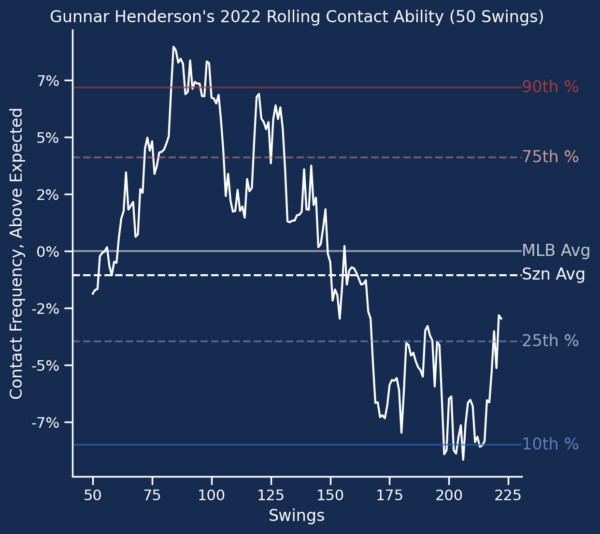
Strikeouts were a bit of a problem for Gunnar in the minor leagues, and unless he can find ways to make contact with more pitches when he chooses to swing—which he did well early on and could certainly improve on during the offseason and regular season—Gunnar’s batting average could be too limited to help him break into the higher tier of third basemen even if he surprises us with more power and speed.
Tier 4
18. Jeremy Peña (HOU), SS
Despite growing pains over the summer that made sent him to many fantasy waiver wires, Peña finished 2022 with 22 home runs, 11 stolen bases, and enough counting stats to finish as fantasy’s 17th-best shortstop, right behind the guy he replaced in Houston (Carlos Correa).
I want to be excited about Peña, and the good news is that he’s almost certainly locked into the shortstop gig for Houston for the foreseeable future as long as he can resemble a league-average hitter thanks to his elite defensive skills. Further, Peña did show improvements at the plate after dealing with that painful summer adjustment period. For example, the chart below shows that Peña’s contact ability was well above league average for the vast majority of the season, and bounced between the top 75th and 90th percentile by the end of the year:
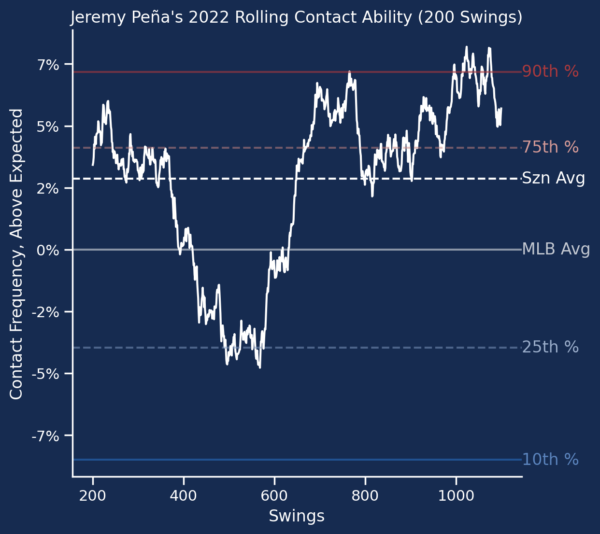
The power didn’t quite rebound as quickly as his contact skills, but at the end of the season, Peña did show signs of an upswing that also extended into the postseason, where he hit .345/.367/.638 with four home runs in 13 games as part of Houston’s World Series victory.

In less promising news, though, Peña seemed to get worse at managing the strike zone when he fell behind, going from above average to well below average as the season progressed:
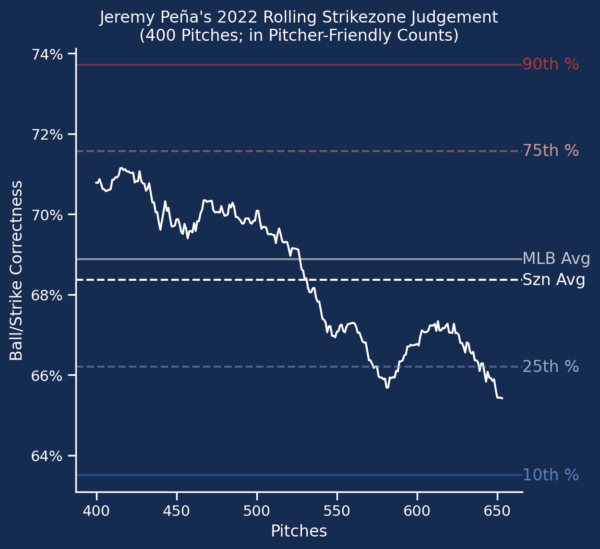
I’m hoping the last chart isn’t a harbinger of bad news, like an exploitable hole in his swing, and that it’ll merely be a blip on the radar after 2023. It definitely adds risk, though, and it’s why I don’t rank Peña as a starting shortstop in 12-team formats.
19. Gleyber Torres (NYY), 2B/SS
After pulverizing the “rabbit ball” and the Orioles in 2019, Torres took some big steps back in 2020 and 2021 before rounding into the player we expected in 2022. Like most projection systems, I’m discrediting both the good (2019) and the bad (2020-2021) and believing that Torres is 20-25 home run hitter who can steal double-digit bases and hit somewhere between .250 and .260.
Speaking of steals, Torres is exactly the kind of player who may see that moderate bump from the rule changes regarding steals that you keep hearing about. He attempted 20 steals in 2021 and 15 in 2022, and the rule changes should help him improve on his fairly mediocre success rate (68% in the last two seasons). Torres is projected to hit at the top of the Yankee lineup, and while there’s not a huge need to run when Aaron Judge is batting behind you, he could certainly get to 15 or more swipes if he can get 20 green lights.
20. Amed Rosario (CLE), SS/OF
Amed Rosario doesn’t walk and doesn’t hit for much power (he has just 11 home runs in each of the last two seasons), but putting the ball in play has led to back-to-back seasons with a batting average better than .280 and 31 combined stolen bases. Rosario is also quite durable heading into his age-27 season, having played at least 141 games in each season since becoming a full-time player for the Mets in 2018.
There isn’t much ceiling to be found for Rosario, as he’s not very good at barreling the ball and hits almost twice as many grounders as he does fly balls, but Rosario’s propensity for spraying the ball to all fields and Cleveland’s willingness to give Rosario the green light means he should be able to get to continue putting up double-digit home runs with 15-20 stolen bases and a decent batting average. It’s a great floor for deeper leagues, and his outfield eligibility is fairly useful, particularly in leagues requiring five starting outfielders.
Tier 5
21. Jorge Polanco (MIN), 2B/SS
Injuries shortened a somewhat disappointing season for Polanco, who hit just .234 with significantly less power than he showcased in 2021. Those 33 home runs from 2021 may prove to be an outlier, but a healthy Polanco is more than capable of hitting 22-25 home runs with a batting average closer to .270 than .240.
One odd development from 2022 that I’m struggling to factor in was the big spike in walk rate—he ended the season walking in 14.4% of hit plate appearances, which is more than double how often Polanco walked in 2021 (7%), and almost six points higher than any other full-season walk rate (8.5% in 2019). That number was actually fairly consistent all season—Polanco’s walk rate was at least 11.8% in every single month, and in 91 July plate appearances, he actually walked more than he struck out! As the rolling chart below will show you, it’s truly a remarkable change, particularly for a player who has been around as long as Polanco:
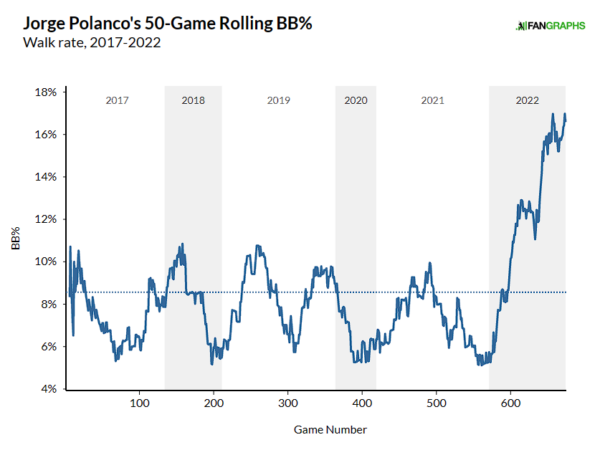
The increase in walks, theoretically, would give Polanco a big boost in OBP formats and also help him score more runs, but it’s hard to project how this type of outlier might carry over into the next season.
22. Nico Hoerner (CHC), SS
10 home runs and 20 stolen bases made Hoerner’s 2022 a pretty big success considering expectations, and while I’m a fan of Hoerner’s contact skills and his ability to keep the ball off the ground more often than he doesn’t, Hoerner’s overall skillset feels a lot like Amed Rosario’s.
The good news for Hoerner is that he should gain valuable second base eligibility within the first two weeks of the season, adding to his fantasy usefulness, and he also should lead off as opposed to batting near the bottom-third of the order as he often did in 2021. That should help Hoerner threaten 20 stolen bases and score 75 or so runs, which is a much better application of his limited power and high batting average. Like Rosario, there isn’t much ceiling here, and in fact, it’s probably just a touch lower as I believe a little more in Rosario’s power and supporting cast. That said, I think Hoerner’s batting average and OBP have much higher floors and his stolen bases have a higher ceiling, which may be of more interest to you at this point in drafts.
23. Thairo Estrada (SFG), 2B/SS/OF
Thairo Estrada is one of those who just did a little bit of everything in 2022—a bit of pop, more than a bit of speed, decent ratios, and more than his fair share of runs and RBI. While none of his statistical contributions will wow you on their own, their cumulative value was enough to sneak into the top 10 at second base last season when all was said and done.
Estrada appears to be the front-runner to leadoff for the Giants, and while that offense isn’t exactly fearsome, there’s just enough thump behind him in the order to believe that he can notch 80 runs if he plays most of the season. If you combine that with the rule changes that promote speed and the fact that the Giants will likely find themselves in a position where they need to manufacture runs on the regular, a 15-home run, 20-stolen base season seems more than reasonable. That power and speed, along with 80 runs scored and a .260 batting average, come together to be a back-end starter at second base in 12-team formats, albeit one with a bit of a lower ceiling than others in this tier.
24. Javier Báez (DET), SS
Javy finally did what y’all have been asking him to do for a long time—he cut down on the strikeouts. The problem, of course, is that he lacked the explosive power that was the hallmark of his game, and it didn’t actually improve his batting average as he put too many balls on the ground. Báez also increased his chase rate to an eye-popping 48.7% while lowering his swing rate at pitches in the zone to a less-than-ideal 69.1%.
Heading into his age-30 season, Javy probably isn’t going to hit 30 home runs again—even with the walls coming in and down a bit in spacious Comerica Park. A return to 20-25 home runs could be in the cards if he can put a few more balls in the air, and the rule changes should help him get to double-digit steals as the Tigers can’t just rely on hitting to bring runners home. Javy’s history, power, and speed might give him a little bit of a higher ceiling than some others in this tier, but his free-swinging and oft-missing tendencies also give him a lower floor.
25. CJ Abrams (WAS), 2B/SS
Once a highly-touted prospect, the shine has faded a bit for Abrams over the last season or two as the power hasn’t quite materialized in the major leagues. From what we’ve seen so far, Abrams has a rather familiar fantasy profile—10-home run pop, 20-stolen base speed, and a very aggressive approach (56.6% swing rate was 14th-highest among players with 300 or more plate appearances) that will likely hamper his batting average and OBP. Abrams doesn’t really strike out much—his 16.6% strikeout rate was well below the league average of 22.4% last season—but his 1.7% walk rate means he’s entirely reliant on getting hits to get on base.
While getting on base is a key skill for all players (it’s kind of the point of being in the batter’s box), it’s especially important for Abrams as his primary attribute right now is his 91st-percentile speed (per Statcast). The 22-year-old middle infielder’s raw speed suggests he could reach 25 or more steals given the opportunity, but Abrams needs to work on his selectivity at the plate, as making contact with pitches well outside of the zone is not a good way to get on base.
On the bright side, Abrams is really skilled at making contact, so if you want to dream about Abrams taking a step forward and being a 15-home run, 30-stolen base player like the old Whit Merrifield, I’ve got a chart that might help:
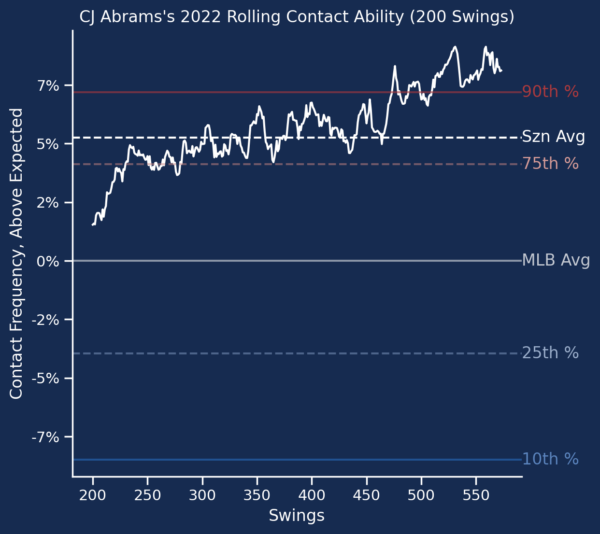
26. Jake Cronenworth (SDP), 1B/2B/SS
The power took a significant step back for Cronenworth in 2022 as he hit just 17 home runs and slugged a mere .390 across his 684 plate appearances last season. While Cronenworth did manage to put the ball in the air more often (47.7% flyball rate in 2022 compared to 36.1% in 2021), he did the opposite of Brandon Drury and pulled just 19.5% of the balls he hit in the air. If you recall from the chart back in Drury’s section, that’s not such a good thing.
Cronenworth could possibly get back to 20 home runs in 2023 if he can just pull the ball a little bit more, and doing so would likely boost his RBI total as he’s shaping up to bat fifth in the top-heavy Padres lineup. Granted, Cronenworth still managed to drive in 88 runners and score 88 times despite the low power thanks to the overall strength of the lineup in San Diego. There’s upside for a top-12 to top-15 season at the position if he can regain some of the power, though if he doesn’t, Cronenworth should still have a reasonably safe floor thanks to the team he plays for and where he’ll hit in the lineup.
Tier 6
27. Ezequiel Tovar (COL), SS
Tovar should be the Rockies’ starting shortstop for most of the season, and his power and speed give him a somewhat exciting profile despite very little experience above Double-A. Based on what projection systems are telling me and what prospect gurus are telling me, we could be looking at 20 home runs and 15 steals if everything comes together perfectly.
This is the Rockies, though, and that doesn’t happen in Colorado. Instead, we’ve come to expect young players to get jerked around and arbitrarily sent to the minors or benched instead of getting a chance to succeed. There’s plenty of intrigue here for dynasty players, but shallow mixed-league players should take a wait-and-see approach.
28. Gavin Lux (LAD), 2B/SS/OF
After hitting 28 home runs across Double-A, Triple-A, and the majors in 2019, Lux was on top of the world. He was considered a top-five prospect in many circles thanks to his promising power and impressive hit tool, and there was hope that he could deliver strong performances in the big leagues as early as 2021. Unfortunately, it hasn’t yet worked out that way either in fantasy or reality, as Lux has just 18 home runs and a .253 batting average in 273 games in the majors.
While it’s still a bit too early to write the 25-year-old kid off, it’s probably safe to say that we’ve had to lower our expectations with respect to what Lux can do. On one hand, we should be encouraged by the .276 batting average and .346 OBP he had in 2022, though his numbers certainly waned in the second half. A breakout for Lux probably looks like a 15-20 home run player with plus batting average and OBP, though the counting stats may be a bit lacking unless he can pull himself out of the bottom of the batting order. That’s somewhat interesting, though the floor is a guy who struggles to hit 10 home runs and to be fantasy-relevant with that kind of limited power you need to either pile in the runs scored at the top of the order or contend for batting titles (or in other words, you have to be Luis Arraez).
29. Luis Urías (MIL), 2B/3B/SS
The .239 batting average probably doesn’t make you all that eager to add Urías to your queue or watch list, but the 25-year-old infielder has just enough pop and versatility to be interesting at the end of a 12-team roster. He’s unlikely to steal more than a handful of bases (even with the rule changes), but Urías does have 20-25 home run power and should provide 70 or more runs and RBI—especially if a few other Brewers like Jesse Winker and Garrett Mitchell are able to find success.
Folks in daily moves leagues that like to burn and churn the back of their roster (which is an excellent strategy if you have the time to manage it) might also take note that Urías has a career line of .281/.349/.456 against southpaws and could easily find himself batting third or fourth against them.
30. Adalberto Mondesi (BOS), SS
Mondesi has played 50 games over the last two seasons, and while he has 20 steals in that time, he also has an abysmal .205/.251/.364 batting line. Mondesi might have some explosive power and speed, but unfortunately, Mondesi can’t hit.
The loss of Trevor Story has made the Red Sox desperate enough to give Mondesi a shot, and those in draft-and-hold leagues can take a flyer if they want, assuming they don’t actually need Mondesi to do anything to feel good about their roster. If he somehow stays healthy and hits north of .210 for a while, maybe pick him up and stream him. Or don’t. That’s fine too.
Photo by Icon Sportswire | Adapted by Doug Carlin (@Bdougals on Twitter)

What about Peraza for the yanks?
Hey again, Ryan!
I think Peraza could be interesting if he can wing that shortstop gig outright and get himself to 400+ PA. If you believe that’s going to happen, go ahead and slot him in that last in Tier 5—especially if you’re playing in a best ball league or something.
And of course, if you want to swap someone else in for Mondesi, go right ahead. I won’t stop you. He’d be in this very same tier (as Tier 6 should probably have a total of like 10 guys).
Hey! Haha. You think Volpe gets it? He seemed to struggle in the upper minors last season.
I’d expect Volpe to be up at some point, probably mid-season or so? He struggled a little, but it was only 22 games. The Yankees will probably shuffle around their infield quite a bit, so I’m hedging those bets a little in a 12-teamer.